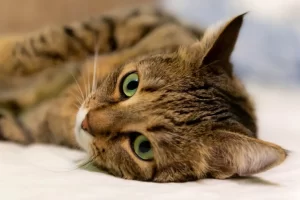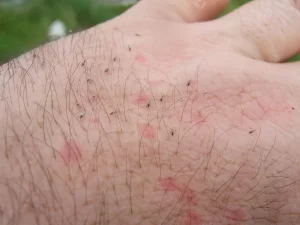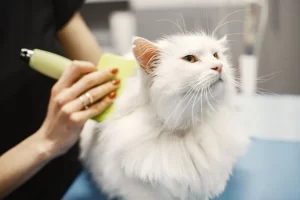Mange is a skin condition in cats caused by mites that can lead to itching, hair loss, and skin irritation. Although it can be treated with conventional veterinary treatments, many pet owners are seeking more natural and cost-effective alternatives. In this article, we will explore the causes, symptoms, and home remedies for mange in cats, as well as important considerations for preventing and managing this condition. Whether you’re looking to treat your feline friend’s mange or want to take steps to prevent it, this comprehensive guide will provide you with the information you need to make informed decisions about your cat’s care.
Table of Contents
ToggleIntroduction to mange in cats
Mange is a skin disease in cats caused by tiny mites that burrow into the skin and cause intense itching, inflammation, and hair loss. It is a common condition that affects cats of all ages and breeds and can be difficult to treat without the proper knowledge and tools.
An interesting fact about mange in cats is that it can be easily spread from one cat to another, especially in multi-cat households, shelters, and breeding facilities. The mites that cause mange can survive for several days on bedding, grooming tools, and even clothing, making it easy for them to be transmitted from one host to another.
Another interesting fact about mange is that it can have several different forms, each with its own set of symptoms, causes, and treatments. The most common types of mange in cats include sarcoptic mange, demodectic mange, and cheyletiellosis. It is important to properly diagnose the type of mange in order to determine the most effective treatment approach.
Causes of mange in cats
The causes of mange in cats can be classified into two main categories: primary and secondary.
Primary causes of mange in cats include:
- Mite infestations – Mites are tiny parasites that burrow into the skin of cats and cause intense itching, inflammation, and hair loss. The most common types of mites that cause mange in cats include sarcoptic mites, demodectic mites, and cheyletiella mites.
- Immune system deficiencies – Cats with weakened immune systems are more susceptible to mange, as their bodies are unable to effectively fight off the mites. Immune system deficiencies can be caused by factors such as genetics, age, stress, poor nutrition, and underlying health conditions.
Secondary causes of mange in cats include:
- Allergies – Cats that are allergic to certain substances, such as food, pollen, or chemicals, can develop mange as a result of the itching and scratching that results from the allergy.
- Skin infections – Bacterial or fungal skin infections can cause mange in cats, as they can lead to weakened skin and greater susceptibility to mite infestations.
- Hormonal imbalances – Hormonal imbalances, such as those caused by thyroid or adrenal gland problems, can lead to mange in cats.
- Stress – Cats that are under a great deal of stress, whether it be from a new environment, a new pet, or a change in routine, can be more susceptible to mange.
can mites be seen by the naked eye?
Symptoms of mange in cats
The symptoms of mange in cats can vary depending on the type of mange and the severity of the infestation, but some common symptoms include:
- Itching and scratching – The most noticeable symptom of mange in cats is intense itching and scratching, which can lead to skin irritation, redness, and hair loss.
- Skin lesions – Mange can cause skin lesions, which are raised, red, and scaly patches that are often surrounded by hair loss.
- Bald patches – Hair loss is a common symptom of mange in cats, as the mites burrow into the skin and cause hair follicles to become irritated and fall out.
- Crusting and scabbing – Mange can cause the skin to become thick and crusty, and can also lead to the formation of scabs on the affected areas.
- Skin irritation – Cats with mange may experience skin irritation and redness, especially around the affected areas.
- Oozing and discharge – Mange can cause the skin to ooze and discharge, especially in severe cases.
- Decreased appetite – Cats with mange may experience a decreased appetite due to the discomfort and itching associated with the condition.
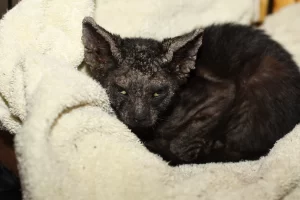
Conventional treatments for mange in cats
Conventional treatments for mange in cats typically involve the use of topical and/or oral medications, and can include the following:
- Topical medications – Topical medications, such as moxidectin and ivermectin, are often used to kill the mites that cause mange and provide relief from itching and skin irritation.
- Antibiotics – In cases where a secondary skin infection is present, antibiotics may be prescribed to clear the infection and prevent further complications.
- Anti-inflammatory medications – Anti-inflammatory medications, such as corticosteroids, can be used to reduce skin inflammation and itching associated with mange.
- Immune-modulating medications – Immune-modulating medications, such as cyclosporine, can be used to boost the immune system and help the body fight off the mites that cause mange.
- Shampoo and dips – Medicated shampoos and dips can be used to cleanse the skin and kill mites on contact.
Risks and side effects of conventional treatments
The use of conventional treatments for mange in cats can be effective in resolving the condition, but there are also risks and side effects associated with these treatments. Some common risks and side effects of conventional mange treatments include:
- Skin irritation – Topical medications and shampoos can sometimes cause skin irritation and redness, especially in cats with sensitive skin.
- Allergic reactions – Cats can develop an allergic reaction to the medications used to treat mange, which can cause symptoms such as itching, swelling, and hives.
- Systemic side effects – Oral medications used to treat mange can cause systemic side effects, such as vomiting, diarrhea, and loss of appetite.
- Interactions with other medications – Some conventional treatments for mange can interact with other medications, making them less effective or potentially harmful.
- Ineffectiveness – In some cases, conventional treatments for mange may not be effective in resolving the condition, especially in severe cases or in cats with a weakened immune system.
Discuss the risks and benefits of conventional treatments for mange in cats with your veterinarian, and to carefully follow all instructions and precautions to minimize the risk of side effects and ensure the best possible outcome.
Mange in cats treatment at home
The main home remedies to get rid of mange in cats are:
- Tea tree oil – Tea tree oil has antiseptic and anti-inflammatory properties, making it an effective home remedy for mange in cats. To use, dilute a few drops of tea tree oil in a carrier oil (such as coconut oil) and apply it to the affected areas.
- Apple cider vinegar – Apple cider vinegar has antifungal and antibacterial properties, making it an effective home remedy for mange in cats. To use, dilute equal parts apple cider vinegar and water and use a cotton ball to apply to the affected areas.
- Aloe vera – Aloe vera is a natural anti-inflammatory that can provide relief from itching and skin irritation associated with mange. To use, break off a leaf of an aloe vera plant and apply the gel directly to the affected areas.
- Coconut oil – Coconut oil has antifungal, antiviral, and antibacterial properties, making it an effective home remedy for mange in cats. To use, apply a small amount of coconut oil to the affected areas.
- Neem oil – Neem oil has antifungal and antiparasitic properties, making it an effective home remedy for mange in cats. To use, dilute a few drops of neem oil in a carrier oil (such as coconut oil) and apply it to the affected areas.
- Olive oil – Olive oil has antifungal and antibacterial properties, making it an effective home remedy for mange in cats. To use, apply a small amount of olive oil to the affected areas.
- Colloidal silver – Colloidal silver has antimicrobial properties, making it an effective home remedy for mange in cats. To use, spray colloidal silver directly on the affected areas.
- Borax – Borax has antifungal and antibacterial properties, making it an effective home remedy for mange in cats. To use, dilute borax in water and use a cotton ball to apply to the affected areas.
- Garlic – Garlic has antifungal and antibacterial properties, making it an effective home remedy for mange in cats. To use, chop fresh garlic and mix it with coconut oil. Apply to the affected areas.
- Lemon juice – Lemon juice has antibacterial properties, making it an effective home remedy for mange in cats. To use, dilute lemon juice with water and use a cotton ball to apply to the affected areas.
- Epsom salt – Epsom salt has antifungal and antibacterial properties, making it an effective home remedy for mange in cats. To use, dissolve Epsom salt in a bath and soak the affected areas.
- Baking soda – Baking soda has antifungal and antibacterial properties, making it an effective home remedy for mange in cats. To use, mix baking soda with water to form a paste and apply it to the affected areas.
- Essential oils – Essential oils, such as lavender and eucalyptus, have antiseptic and anti-inflammatory properties, making them effective home remedies for mange in cats. To use, dilute a few drops of the essential oil in a carrier oil (such as coconut oil) and apply to the affected areas.
- Turmeric – Turmeric has antifungal and antibacterial properties, making it an effective home remedy for mange in cats. To use, mix turmeric powder with water to form a paste and apply to the affected areas.
Precautions to take when using home remedies for mange in cats
- Always dilute essential oils before use.
- Test a small area first to check for skin irritation.
- Consult with a veterinarian before using any home remedy.
- Use gloves to avoid skin contact.
- Keep away from the cat’s eyes, nose, and mouth.
- Avoid using essential oils on pregnant or nursing cats.
- Store essential oils and other remedies out of reach of the cat.
- Do not use remedies that contain ingredients known to be toxic to cats.
- Avoid using remedies that may interfere with any medications the cat is currently taking.
- Monitor the cat for any adverse reactions to the remedy.
- If symptoms persist or worsen, discontinue use and consult with a veterinarian.
Proper diet, nutrition, and supplements for mange in cats
- A balanced and nutritious diet: A balanced and nutritious diet is important for a cat’s overall health and can help support their immune system, making it easier to fight mange. Feed them a diet high in protein and essential vitamins and minerals, such as vitamin E and omega-3 fatty acids.
- Supplements: Certain supplements may help boost the cat’s immune system and promote healthy skin. Some options include vitamins A, C, and E, as well as omega-3 fatty acids and biotin. Consult with a veterinarian to determine the right dosage and ensure they don’t interfere with any existing medications.
- Probiotics: Probiotics can help balance the bacteria in the gut, which can in turn improve the skin and immune system. They can be given in supplement form or added to the cat’s food.
- Fish oil: Fish oil is rich in omega-3 fatty acids and can help soothe itchy skin and boost the immune system. It can be added to the cat’s food or given as a supplement.
- Essential fatty acids: Essential fatty acids such as linoleic acid and arachidonic acid can help support the skin and promote a healthy coat. They can be found in certain foods or given as a supplement.
Preventing mange in cats
Follow these steps to save your cat from getting mange.
- Keep the cat’s environment clean and free of debris.
- Regularly groom and bathe the cat to remove any mites or eggs.
- Control fleas and ticks using these natural remedies as they can carry mange mites.
- Avoid overcrowding and stress to help maintain the cat’s immune system.
- Regular vet check-ups and parasite treatments.
- Maintain a balanced and nutritious diet.
- Keep the cat away from infected animals.
- Implement good hygiene practices, such as washing hands and clothing after handling infected animals.
- Keep the cat indoors to reduce exposure to mites.
- Promptly treat any skin injuries to prevent secondary infections.
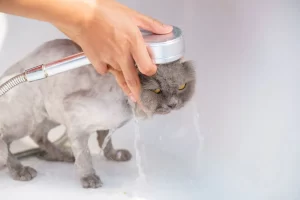
Bathing and grooming for mange in cats
- Regular bathing: Regular bathing can help remove mites and eggs from the cat’s fur. Use a medicated shampoo or a solution of warm water and vinegar.
- Grooming: Regular grooming can help remove mites and their eggs and promote healthy skin. Use a fine-toothed comb or brush to remove any mites or debris from the fur.
- Clean bedding: Regularly wash and replace the cat’s bedding to prevent re-infestation.
- Avoid sharing grooming tools: Don’t share grooming tools with other pets to prevent cross-contamination.
Usage instructions:
- Consult with a veterinarian before using any new grooming products.
- Gradually increase the frequency and duration of baths to avoid upsetting the cat.
- Rinse the cat thoroughly to remove all soap and shampoo residue.
- Gently dry the cat after bathing and avoid exposing them to drafts.
Understanding the life cycle of mites causing mange
Understanding the life cycle of mange mites is important because it helps pet owners:
- Identify the severity of the infestation: Understanding the mites’ reproductive capabilities can help pet owners assess the severity of the infestation and determine the best course of treatment.
- Choose effective treatments: Understanding the life cycle of mange mites can help pet owners choose treatments that target different stages of the life cycle, providing more comprehensive control of the infestation.
- Avoid re-infestation: By understanding the mites’ life cycle, pet owners can take measures to prevent re-infestation, such as washing bedding and avoiding sharing grooming tools.
- Track progress of treatment: Monitoring the life cycle of mange mites can help pet owners track the progress of treatment and determine if it is working effectively.
The life cycle of mange mites is as follows:
- Mites: Mites are tiny parasitic insects that feed on the skin of animals, including cats. Mange mites burrow into the skin and lay eggs, leading to skin irritation and inflammation.
- Life cycle: The life cycle of mange mites includes egg, larva, nymph, and adult stages. The mites can reproduce quickly and lay up to 10 eggs a day.
- Egg stage: The eggs hatch into larvae within 3-4 days.
- Larval stage: The larvae molt into nymphs within 2-3 days.
- Nymph stage: The nymphs feed on the skin and then molt into adult mites within 2-3 days.
- Adult stage: The adult mites feed on the skin and lay eggs, starting the cycle anew.
Understanding the life cycle of mange mites can help pet owners better understand the severity and persistence of the condition and inform their choice of treatment.
Environmental factors affecting mange in cats
Environmental factors that can affect mange in cats include:
- Crowded living conditions: Crowded living conditions increase the risk of mites spreading from one cat to another.
- Poor hygiene: Poor hygiene can lead to a buildup of mites on surfaces and increase the risk of infestation.
- Exposure to infected animals: Cats that come into contact with infected animals, such as feral cats or other household pets, are more likely to develop mange.
- Seasonal changes: Mite infestations may be more common during certain times of the year, such as during the warmer months when mites are more active.
- Climate: Humid or warm climates can be more favorable for mite growth and reproduction, increasing the risk of infestation.
- Stressed immune system: Cats with weakened immune systems may be more susceptible to mange mite infestations.
Understanding these environmental factors can help pet owners identify the root cause of mange in their cats and take steps to reduce the risk of infestation.
Importance of early diagnosis and treatment for mange in cats
Early diagnosis and treatment of mange in cats are important because:
- Minimizes discomfort: Mange can cause severe itching and skin irritation in cats. Early treatment can help minimize discomfort and prevent secondary infections.
- Prevents spread: Mange mites can spread easily from one cat to another, particularly in crowded living conditions. Early treatment can help prevent the spread of mites to other cats.
- Avoids complications: If left untreated, mange can lead to complications such as skin infections and hair loss. Early treatment can help avoid these complications.
- Improves prognosis: Early treatment can lead to a faster and more complete resolution of the infestation, improving the prognosis for affected cats.
- Saves resources: Early treatment of mange can save pet owners time and money, as more advanced cases may require more extensive treatments.
Read more on How often do you take a cat to the vet?
Managing stress and boosting immunity in mange-affected cats
Managing stress and boosting immunity in mange-affected cats can help improve the outcome of treatment and prevent the recurrence of the infestation. Some strategies include:
- Reducing stress: Providing a calm and low-stress environment, such as a quiet room with soft bedding, can help reduce stress in affected cats.
- Providing proper nutrition: A balanced diet high in essential nutrients and vitamins can help support the immune system and reduce stress.
- Supplements: Supplements, such as omega-3 fatty acids and vitamins, can help boost the immune system and reduce inflammation.
- Regular exercise: Regular exercise can help reduce stress and boost the immune system.
- Routine veterinary check-ups: Regular check-ups can help detect and manage any potential stressors or health problems that may weaken the immune system.
- Pheromone therapy: Using pheromone sprays or diffusers can help reduce stress and improve the overall well-being of affected cats.
By managing stress and boosting immunity, pet owners can help improve the outcome of treatment and prevent the recurrence of mange in their cats.
Cost comparison of home remedies vs conventional treatments
The cost of treating mange in cats can vary significantly based on the approach chosen. Conventional treatments, such as prescription medications and vet visits, tend to be more expensive than home remedies. On the other hand, home remedies may require a larger upfront investment in ingredients but can be more cost-effective in the long run.
It’s important to consider both the cost and the potential benefits of each approach when making a decision. Conventional treatments can range from $50 to $200 or more, including:
- Prescription medications: $30 to $100 per bottle
- Vet visits: $50 to $150 or more per visit
- Diagnostic tests: $50 to $150 or more
- Follow-up visits: $50 to $150 or more per visit
The cost of home remedies can vary greatly but may range from $20 to $50 or more, including:
- Ingredients (such as oils, herbs, supplements): $10 to $40 or more
- Supplies (such as a bathing basin or brushes): $10 to $20 or more
Ultimately, the cost of treating mange in cats will depend on the specific approach, the severity of the infestation, and the pet owner’s location. Pet owners should consult their veterinarian to determine the best course of action for their individual pets.
potential complications if left untreated
If mange in cats is left untreated, it can lead to several potential complications, including:
- Secondary infections: Uncontrolled mite infestations can lead to skin irritation and open wounds, which are vulnerable to bacterial infections. In such cases, your cat may benefit from these natural antibiotics that you can try at home.
- Spread of mites: Mites can spread from an affected cat to other cats or even to humans, leading to additional infestations.
- Scarring: Chronic or severe cases of mange can result in scarring, which can impact the appearance and health of the affected skin.
- Immunity suppression: Chronic skin irritation and infections can weaken the immune system, making the cat more vulnerable to other health issues.
- Reduced quality of life: Uncomfortable symptoms such as itching, redness, and hair loss can cause discomfort and reduce a cat’s overall quality of life.
Therefore, early diagnosis and treatment of mange are crucial to prevent the development of these complications and to ensure the best outcome for the affected cat.
Which vet to visit with what expertise?
If your cat has symptoms of mange, it is recommended to see a veterinarian with expertise in dermatology or skin conditions. A veterinary dermatologist is a specialist who has completed advanced training in the diagnosis and treatment of skin diseases in animals, including mange. They have the knowledge and expertise to diagnose the type of mange and determine the best course of treatment for your cat.
In general practice, your regular veterinarian may be able to diagnose and treat common forms of mange, but in more complex cases, they may refer you to a veterinary dermatologist for a more specialized evaluation and treatment plan.










